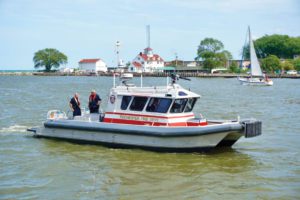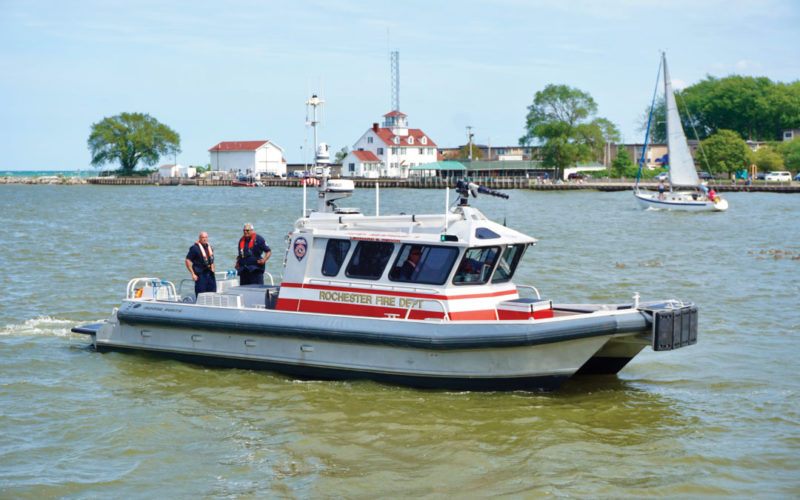
Firefighter Casey Brennan steered Rochester (N.Y.) Fire Department’s newest asset north in the Genesee River. Whitecaps dotted the horizon as a 15-knot headwind pushed against the bow.
Conditions worsened after the vessel cleared the jetties and moved into the open waters of Lake Ontario.
“Hold on boys,” Brennan said. “We’re going to come up a bit.”
With that, he pushed the throttles down on Marine 1’s twin 425-hp Cummins diesels. It quickly accelerated to 21 knots while handling 4- and 5-foot waves.
“It responds like that,” Brennan said, with the snap of his fingers.
Lt. Scott Toly, positioned to Brennan’s left in the navigator’s seat, rated the conditions a “six out of 10” for Lake Ontario.
“It is a little uncomfortable, and with anything bigger it starts getting a little more uncomfortable, but this boat can handle more than this,” he said.
Marine 1 is ceremonially named Leonard E. Redon after a late Rochester deputy mayor who supported the city’s fireboat acquisition. The vessel arrived in July 2021 and entered service a few weeks later. Moose Boats of Vallejo, Calif., built the aluminum catamaran based on its M2-38 platform.
Marine 1 can flow more than 1,500 gallons of water per minute through two fire monitors, while its Cummins engines and HamiltonJet waterjets push the vessel to 34 knots in open water. The climate-controlled cabin has seating for three people, with a 7-foot bench for transporting injured people and stretchers.
The fireboat is the first of its kind for the Rochester Fire Department, which serves a community of 211,000 residents. The city has frontage on Lake Ontario and is bisected by the Genesee River. Previously, the department responded to most water emergencies using a 16-foot open skiff.
The department first proposed adding a dedicated fireboat as far back as 1994, according to Battalion Chief Pat Agostinelli. A recent state grant with a local match made the new vessel possible.
Marine 1 greatly expands the department’s capabilities and cuts response times within the city nearly in half. It also enhances fire and rescue capabilities within Lake Ontario through mutual aid agreements with other departments.
“We wanted something that was very capable, big enough to handle the lake, with a big rescue platform and a big cabin, and the ability to dispense a large amount of water,” Agostinelli said during an interview at the Lake Avenue Firehouse in Rochester. “We also wanted the ability to supply land units and be able to put out any fire that was in the water or in the (Genesee River) gorge.”
The city’s marine firefighting and rescue needs are unusual. The Genesee River gorge can be steep and remote, making it difficult to fight fires and rescue injured people. The lack of fire hydrants is another challenge. Some brushfires in woods along the river have been extinguished by bucket brigades.
The Port of Rochester has limited commercial shipping activity, but the mouth of the Genesee is lined with restaurants and marinas offering more than 1,000 vessel slips. Injuries and serious boating accidents happen with some regularity on two 2,300-foot jetty piers extending into Lake Ontario.
The fire department considered multiple fireboat designs and visited other Great Lakes fire departments before making the purchase. It awarded the contract to Moose Boats through a competitive bidding process. Marine 1 is the first Moose Boats fireboat working on the Lakes.
“The design of this boat helps us take on the large waves of the lake, adding a stable platform to work off, while giving us the ability to maneuver in shallow waters of the river drafting less than 2 feet,” Capt. Scott Daly said. “The stability of the platform in rough water, the state-of-the-art electronics [and] the fire-EMS rescue equipment make this boat one of the most capable rescue boats on the southern shore of Lake Ontario.”
Marine 1 docks at a marina a mile or so from the Lake Avenue Firehouse. It is fully manned during summer holiday weekends but otherwise is crewed by four firefighters who respond to emergency calls from the firehouse. The team consists of an operator, an officer overseeing the response and two firefighters working on deck.
The department worked with the Coast Guard to develop an in-house training program. Each member of the marine unit must undergo more than 100 hours of coursework and vessel familiarization. This includes the Boat Operators Search and Rescue (BOSAR) program for operators and the Boat Crew Member (BCM) course for crew.
“Everyone down here is a boater,” said Toly, who like Brennan served in the Navy. “But driving this is different enough that if you don’t use it, you can lose it. You have to keep at it. It is about finesse and feeling.”
The Moose Boats M2-38 platform is optimized for law enforcement and firefighting. The catamaran hull offers a highly stable and maneuverable platform, particularly at slow speeds, according to Ken Royal, Moose Boats’ vice president of sales.
“While Moose carries a signature forward-sloping pilothouse with sleek low freeboard hull, much of the interior is customized” he said.
The cabin is 10 feet long and 8 feet wide, with three shock-mitigating seats. The space is heated and cooled to account for the extreme heat and cold that occur in Rochester, and the front windows are heated to melt ice and frost.
Propulsion comes from twin Cummins QSB6.7 main engines driving HamiltonJet waterjets through Twin Disc reduction gears. Marine 1 has an economical cruising speed of 28 knots, although it typically transits at 5 to 7 knots while underway within the Port of Rochester.
“It is unbelievable,” Brennan said of the vessel’s maneuverability. “You can take this 38-foot boat, sit still and spin it in a circle. You can take this boat and move it sideways.”
Marine 1 is equipped with a 5-foot platform at the transom for water rescues. The lack of spinning propellers, Toly explained, reduces the risk of injury when divers are retrieving someone from the water. The waterjets also reduce the vessel’s draft to just 20 inches.
Marine 1 is equipped with a remote-controlled Task Force Tips monitor on the roof and a manually operated monitor on the port side, aft of the pilothouse. The Hale fire pump, driven off the port engine through a power takeoff, is rated for 1,000 gallons per minute but delivers nearly 1,800, Daly said.
The vessel has a 5-inch Storz discharge point that can supply water to shoreside fire trucks. Marine 1 also can dispense foam when needed to fight certain types of fire.
The pilothouse has two Simrad displays — one for the operator and one for the navigator — paired with the vessel’s radar, AIS and side-scanning sonar system. A third Raymarine display is paired with a roof-mounted FLIR thermal imaging camera. Icom supplied the VHF radios for marine communications, while two Motorola radios allow for communication with other first responders.
Marine 1 has watertight storage forward and aft for firefighting equipment, and the pilothouse is equipped with a small head. The bow is equipped with a push knee, and the upper bulwarks are wrapped in a polyurethane foam collar.
As of late August, the vessel had responded to numerous calls, including a medical emergency on a jetty and a brushfire in the gorge. Both would have proved more difficult with the department’s previous response boat.
“We can handle just about anything at this point,” Agostinelli said. “It is an asset we’ve never had before.” •

